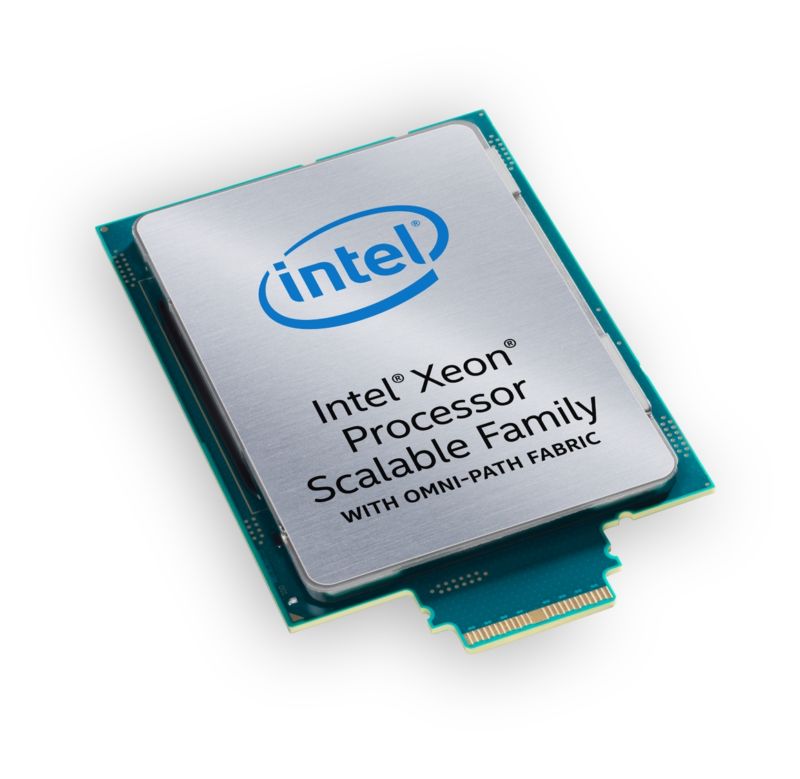
NEW YORK—At a trendy entrepreneurial workspace in Brooklyn, Intel formally launched a new range of Xeon processors powered by its new Skylake-SP core. The new processors offer more cores and more performance than their predecessors, with a new mesh-based design to enable greater scaling within their multicore processors.
The new chips also bring with them a new set of precious metal-based branding, with four metals—Bronze, Silver, Gold, and Platinum—used to denote processor capabilities. Unlike AMD's new Epyc platform, Intel is continuing to segment its features.
Xeon SP ("scalable platform") chips will have up to 28 cores and 56 threads. This high core count prompted Intel to move away from the ring-based design used in prior processors. The ring design arranged cores in one or two loops with core-to-core communication having to go around the ring, potentially requiring data to travel over a dozen or more hops to move between cores. With the new mesh design, the individual cores (along with memory controllers and I/O interfaces) are arranged in a 2D grid (4×4, 4×6, or 6×6, depending on the overall core count), allowing data to move between cores in many fewer hops. This design should help keep the communication latency between the cores low, and it's a key advantage over AMD's Infinity Fabric-based design, which can suffer very high latencies in a number of situations.
Skylake-SP also includes support for the AVX512 instruction set. This vector instruction set enables arithmetic to be performed on vectors of up to 16 single precision floating point numbers in a single operation, up from eight in AVX. The number of AVX registers has also been doubled. To make these wider vectors easier to program, AVX512 also includes complex masking capabilities. With this, an operation can, say, ignore a couple of elements in a vector without having to repack the vector to remove them. This makes complex operations with branches and conditions much easier to express in AVX512 than AVX.
Intel is also promoting security features of Xeon SP. With "Key Protection Technology," the processor can perform encryption and decryption operations without having to put the encryption keys in main system memory. This is designed to make those keys harder for malicious software to steal. Enabling this, Intel is also claiming substantially improved encryption performance.
Unlike the staggered rollouts of the past, Intel is releasing a full range of Xeon SP chips, supporting two, four, and eight or more sockets, together. As well as up to 28 cores, the chips will support up to 1.5TB of memory across six channels and 48 PCIe 3 lanes per processor. AMD is sure to make much hay of this: per chip, Epyc offers up to 32 cores, 2TB of memory across eight channels, and a total of 128 PCIe 3 lanes in both 1-socket and 2-socket systems. Intel's per-core performance is higher, and we'd expect most workloads to favor the Intel chips in spite of their core deficit. But for the most I/O and memory-intensive workloads, AMD may hold the advantage.
-
Platinum processors.Intel
-
Gold processors.Intel
-
Silver and Bronze processors.Intel
Intel's segmentation is unrelenting, creating a product line-up that's substantially more complex than AMD's. That 1.5TB of memory, for example, is only supported on chips named with an "M" suffix; without that M, a Xeon SP is limited to 768GB. Want support for 2,666MHz memory? You'll need a Platinum or Gold part. Bronze is limited to 2,100MHz, Silver to 2,400MHz. Bronze, Silver, and 5000-series Gold only have a single unit for AVX512 fused multiply-accumulates, one of the most important arithmetic operations in vector processing. 6000-series Gold and all Platinum chips have two units, doubling their throughput. Bronze and Silver support up to two sockets; Gold takes that to four, but to go to eight you'll need Platinum. Select Gold and Platinum processors, denoted with an F suffix, also include an integrated OmniPath connector for additional high-speed I/O capabilities.
Anandtech has a full set of prices for the literally dozens of chips being launched. The number everyone will gawp at is that of the 8180M: 28 cores, 56 threads, a base clock speed of 2.5GHz, turboing to 3.8GHz, with 1.5TB memory support: those chips will come in at a cool $13,011 each. Sacrificing the large memory support drops the price to $10,009—that's a steep premium for the larger memory capacity.
While there are rumors that AMD's Ryzen and Threadripper processors caused Intel to shake up its desktop processor offerings—the 18-core Skylake-X parts, available later this year, are believed to be a direct response to AMD's 16-core Threadripper—the pricing and segmentation that Intel is using for Xeon SP suggests that Intel isn't yet feeling the heat from Epyc.
reader comments
98